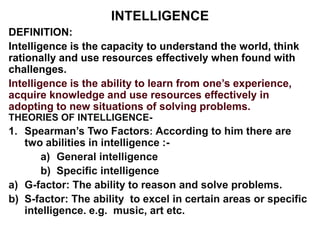
Intelligence
- 1. INTELLIGENCE DEFINITION: Intelligence is the capacity to understand the world, think rationally and use resources effectively when found with challenges. Intelligence is the ability to learn from one’s experience, acquire knowledge and use resources effectively in adopting to new situations of solving problems. THEORIES OF INTELLIGENCE- 1. Spearman’s Two Factors: According to him there are two abilities in intelligence :- a) General intelligence b) Specific intelligence a) G-factor: The ability to reason and solve problems. b) S-factor: The ability to excel in certain areas or specific intelligence. e.g. music, art etc.
- 2. 2. Gardner’s Multiple intelligences : Gardner(1993,1999)said overall intelligence comprises nine different types. They are- 1) Verbal, 2) Musical, 3) Mathematical or logical 4) Visual, 5) Movement, 6) Interpersonal and Intrapersonal, 8) Naturalist, 9) Existentialist 3. Sternberg’s Triarchic Theory : There are three aspects of intelligence- a) Analytical intelligence :The ability to break problems down into component parts or analysis for problem solving. b) Creative intelligence :The ability to deal with new and different concepts and to come up with new ways of solving problems. c) Practical intelligence : The ability to use information to get along in life and become successful.
- 3. MEASURING INTELLIGENCE: Intelligence test means a battery of measures used to determine a person’s level of intelligence. 1) Binet's Mental Ability Test: Alfred Binet a French psychologist, was asked by the French Ministry of Education to design a formal test of intelligence that would help identify children who were reasonable to learn as quickly or well as others so that they could be given remedial education. Binet and his colleague, Simon(1916) came up with a test that not only distinguished between fast and slow learners but also between children of different age groups as well.
- 4. How to measure: Children were assigned a score that corresponded to their mental age, the average age of children taking the test who achieved the same score. For example: If a nine year old boy received a score of 45 on the test and this was the average score received by the 8 years old boy, his mental age would be considered to be 8 years. Mental age concept was given by Alfred Binet.
- 5. 2. STANFORD-BINET TEST : Terman (1916) a researcher at Stanford University, adopted William Stern’s method IQ. Stern’s formula of IQ (Intelligence Quotient): MA/CA×100 For example: If a child who is 10 years old takes the test and scores mental age of 15, the IQ would be : 15/10×100=150 This test is generally used for children.
- 6. 3. THE WECHSLER TEST : David Wechsler (1981,1990,1991) developed an IQ test for adults. He later designed test for older school age children and pre-school age children also. He introduced three version of test. They are: • WAIS: Wechsler Adult Intelligence Scale. • WISC: Wechsler Intelligence scale for children. • WPPSI: Wechsler Pre-school and Primary Scale of intelligence. It measures Verbal Ability and Performance Ability of individual.
- 7. • Verbal ability : It includes: Information, Comprehension, Arithmetic, Similarities, Vocabulary. • Performance ability: Picture arrangement, Picture completion, Block design, Object assembly, Digit symbol. On the Wechsler’s IQ test, the percentages under each section of the normal curve are like this-
- 8. INDIVIDUAL DIFFFERENCES IN INTELLIGENCE: 1) Mental Retardation(Developmental Delay) 2) Giftedness 1. Mental Retardation(Developmental Delay): When a person’s behavioral and cognitive skills exists at an earlier developmental stage is known as developmental delay. It affects intelligence but not on affection, love etc. Criteria: a) The person’s IQ must fall below 70. b) A person’s adoptive behavior is severely below a level appropriate for the person’s age. c) This limitation must be present before the age of 18 years.
- 9. Classification: Causes: a. Environmental: Lead & Mercury poisoning b. Biological : Down Syndrome ,Fetal alcohol syndrome and Fragile X syndrome. c. Other causes are: lack of oxygen at the time of birth, damage to the Fetus due to diseases, infection, drugs or accident. Mental Retardation Level IQ Range 1. Mild Retardation 50-70 2. Moderate Retardation 40-55 3. Severe Retardation 25-40 4. Profound Retardation Below 25
- 10. 2. Giftedness: 2% of the population falling on the upper end of the normal curve and possesses IQ of 130 and above are called gifted person. Gifted persons become successful in life than intelligence and high academic achievement. Criteria: a) IQ > 130 b) IQ>140-They are called genius. Characteristic: a. typically grow up to the well adjusted adults except when pushed to achieve at younger ages. b. Extreme geniuses may experience social and behavioral adjustment issues at childhood.